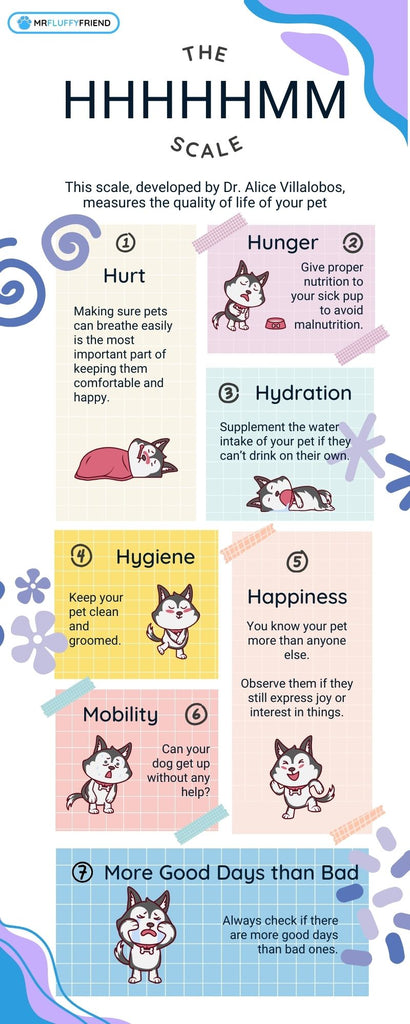Signs To Put Your Dog To Sleep
As his birthday draws near, I dedicate this blog post to my cherished canine companion, Ringo, whose memories continue to warm my heart, even after his gentle hugs have faded away.
Our Fluffy Friends bring boundless joy and unconditional love into our lives.
Dogs are more than just pets—they’re cherished family members.
However, as responsible pet owners, we must face a difficult decision.
This decision is whether or not to let them go when their quality of life declines.
Putting your dog to sleep or euthanising them is a heart-wrenching decision.
Yet, it can be an act of love and compassion when their suffering becomes too great.
Today, we'll explore the signs indicating it's time to say goodbye to your beloved dog.
While this decision is never easy, understanding the signs and seeking guidance from your veterinarian can help.
It ensures your Fluffy Friend's final moments are filled with comfort and surrounded by the love they've always known.
Let's navigate this challenging journey with the utmost care and respect for your loyal best friend.
Click the links below to go to that section:

Serious Signs That Your Dog Is Suffering
Pet parents don't want to talk about dog euthanasia, and for good reason.
Then again, we must discuss it, especially as dog owners of older dogs.
If your dog is almost at the end of their life, it may be challenging to make the appropriate decision for them without prior planning.
Here are some of the common signs that you need to look out for:
1. Discomfort and Pain

Your beloved pet is experiencing discomfort and pain, but how can you tell?
- Discomfort: Some pups may sleep more or find new resting areas when uncomfortable. They may have trouble relaxing and resting.
- Pain: Signs of pain include panting or trembling. Your pet may hide or avoid family interactions. Other pain symptoms include irritation, restlessness, and hostility.
2. Loss of Appetite or Weight Loss
In their final moments, dogs often lose their appetite due to nausea or pain.
Vomiting is also a common sign of an ill pet.
Diarrhoea is a symptom of old age.
If this problem persists and comes with other symptoms, their digestive system may not be working correctly.
Of course, you may see your dog dropping weight quickly.
Pain makes your dog less hungry, which causes weight loss.
3. Incontinence
Some ill dogs lose bladder and bowel control as they might not be able to get up to relieve themselves outside.
Thus, they need help staying clean.
4. Body Odour
A foul smell can occur when a pet's body malfunctions.
Kidney disease, metabolism abnormalities, and hair oil build-up might cause this.
Also, incontinence, dental disease, or poor grooming can contribute to the odour.
Your furry family member’s coat may look drab or untidy due to poor hygiene and care.
They may be too uncomfortable to groom themselves.
They may also be too exhausted and would rely on their loving pet parent to help them.
5. Eye Trouble
Dogs' eyes can fail when approaching their final days.
Your dog may have foggy or dull eyes and when combined with other indicators, they may mean more.
6. Temperature Changes

If your dog is sick, old, or dying, they may easily get hotter or colder.
Hormonal changes can make it hard for your dog to regulate temperature.
7. Disinterest or Lethargy
A sick dog may lose interest in their favourite pastimes or they may even bark less.
They may not wake up to play with toys or their family.
Disinterest may indicate the end of their voyage.
Lack of energy to walk and not acting like themselves may indicate worsening health.
8. Depression or Anxiety
Depression may cause lethargy, weariness, and disinterest in your dog.
Loss of movement or discomfort often causes depression in dying dogs.
Dogs, like people, can feel anxious for many reasons.
This is very true for dogs in pain.
They may be anxious if they whine, pace, cry, or pant.
Dogs can suffer more from anxiety than pain.
9. Confusion
End-of-life pets can feel confused and may even get lost in the house or backyard.
Sometimes they don't recognise you or your family.
10. Clinginess or Detachment
Many dogs desire nothing more than time with their loved ones towards the end.
Therefore, your pooch may want to be near you and ask for attention.
On the other hand, our dogs sometimes refuse to see us near death.
If they prefer peaceful locations to be alone, keeping a watchful eye on them is still a good idea.
11. Movement Problems or Seizures
Senior dogs may have discomfort, stiffness or weakness.
They may have trouble following daily routines or getting up to do their customary things.
The most important thing during this period is to help them be as comfortable as possible.
Some dying dogs have seizures which can be caused by kidney failure, metabolic abnormalities, or neurological issues.
12. Breathing Issues
Many dying dogs have difficulty breathing.
You can either notice them breathe faster or slower or louder or quieter.
13. Good Days Are Less Than Bad Days
When to say farewell to your dog can be a difficult time, especially if symptoms develop slowly.
Some pet owners monitor their dog's good and bad days to track their quality of life.
If there are more bad days than good, it may be time to speak to the vet for the next steps.
There may not be a right time to say goodbye to your dog.
However, there’s often the ‘best time’ for a variety of reasons:
- When a dog has untreatable chronic pain
- When they are seriously hurt and might not survive.
- Poor quality of life means a dog is just ‘existing,’ not ‘living.’
Other potentially challenging scenarios include:
- When behavioural modification and treatments fail to control a dangerously violent dog.
- When you can't afford long-term therapy for your dog's severe, chronic, and terminal illnesses.
- Although your dog may live, their life will be filled with vet visits, pain medications, unpleasant treatments, anxiety, and stress.
Still, there’s no single response that fits all of these and no one knows our pups better than us.
While veterinarians provide competent advice, they only meet our pets briefly and base their findings on generic veterinary concepts.
If your emotions cloud a necessary judgement, a veterinarian's objectivity is needed.
Consult your vet if you're considering putting your dog to sleep due to a chronic, severe, and debilitating condition.
Related: Tips for Pet Surgery Aftercare
Dogs Quality of Life Scale

The Quality of Life Scale is used by vets, scientists, and dog owners to assess a dog’s health condition and quality of life.
It can help check your dog's happiness, emotional wellness, and physical health.
The acronym for the veterinarians' HHHHHMM Scale is Hunger, Hurt, Hydration, Happiness, Hygiene, Mobility, and More good days than bad days.
The scale offers an objective approach to assess changes in your dog's quality of life over time.
It also evaluates how effective the treatments are.
Thus, you can make the right decision for your dog's care.
Related: 5 Reasons To Adopt a Rescue Pet
Final Thoughts
While the signs may signal approaching death, they may also signify a treatable medical condition.
See your vet if you're worried about your dog's quality of life.
This will also let you discuss end-of-life care if needed.
Palliative Care
Ask your vet about palliative treatment to ease your dog's final days.
Imprints and Memorials
Before saying farewell to your pet, think about how you want to remember them.
You may create a bucket list for your pet or revisit their favourite sites and activities in their last moments.
Consider paw imprints in ink or clay to memorialise your pet.
Final Preparations
Finally, decide how to handle your pet's remains.
You can bury or cremate your pet.
Many at-home euthanasia programmes include decision-making assistance.
Related: How to Cope with Losing A Pet

Conclusion
Ultimately, deciding to put your beloved dog to sleep is one of the most challenging decisions a pet owner can make.
Still, it's also an act of profound love and compassion.
If you’re having a hard time, your MrFluffyFriend Team is here to listen.
Looking for some products that could help you out?
Check out our Online Shop!
Here are some useful products in relation to this blog post:

1 comment
One of the hardest decisions I had to make was with my Little Charlie (Jack-Russell for 14 years). Suffered for a while and my Vet was so compassionate with me, yet Charlie and I both knew that day had come. It was so emotional, yet so gentle and quiet as he rested in my arms, but HE was finally at PEACE. That was a great article!!
———
MrFluffyFriend™ replied:
Hi Pam,
Thanks so much for reading and I agree that it’s a very hard decision to make. And thank you for sharing your story, I know sweet Charlie will always be in your heart as my Ringo is in mine forever.
Hugs, Jeaninne